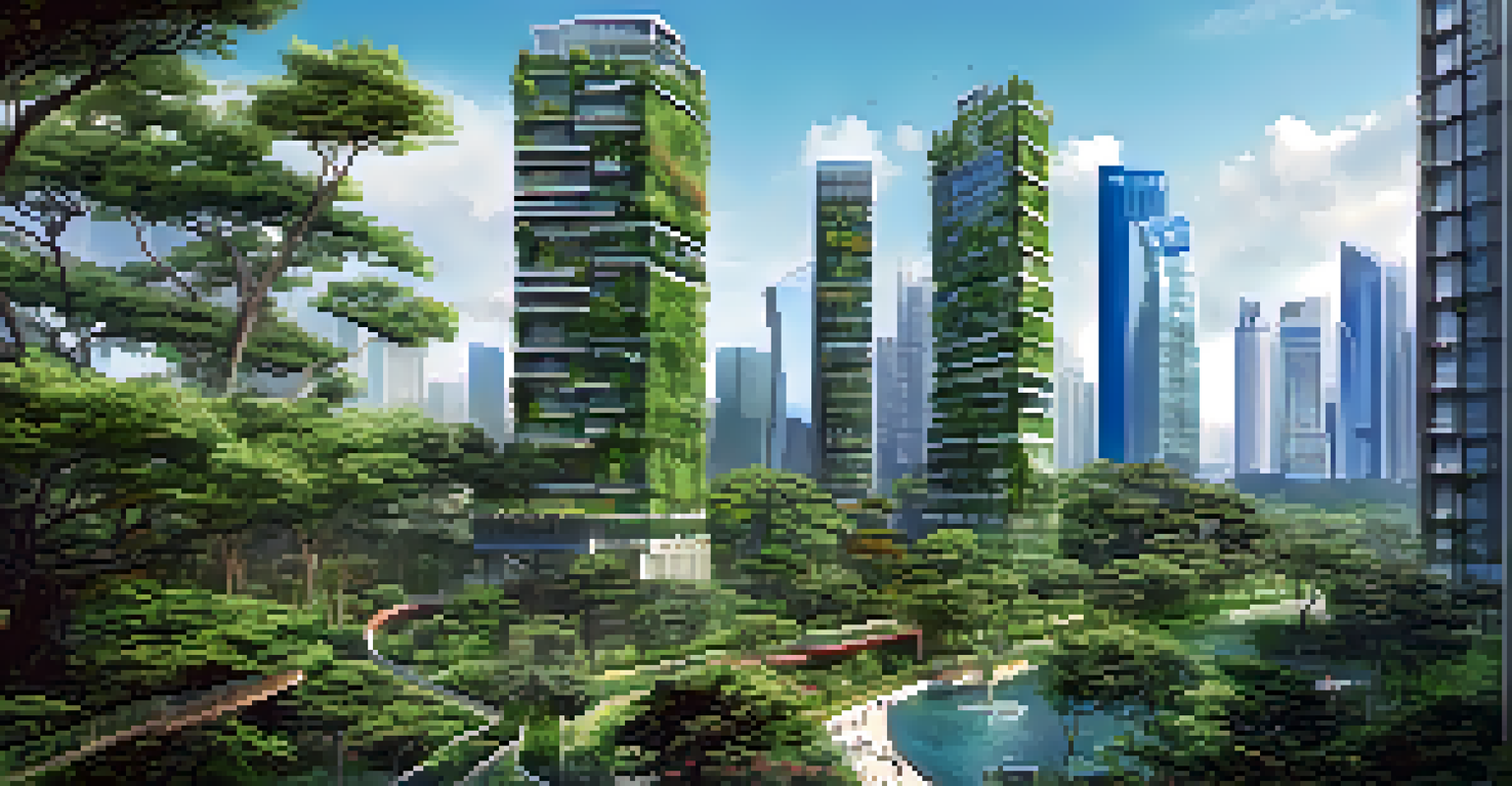Analyzing Trends in Green Building Practices by Region

Understanding Green Building: A Global Perspective
Green building refers to the design, construction, and operation of structures that are environmentally responsible and resource-efficient. This approach considers the entire life cycle of a building, from siting and design to construction and operation. The growing awareness of climate change and resource depletion has made green building practices more relevant than ever.
The greatest threat to our planet is the belief that someone else will save it.
Regions around the world have adopted various green building practices, influenced by local climates, resources, and regulations. For instance, Scandinavian countries often emphasize sustainable materials and energy efficiency, while regions in North America are integrating smart technology into their designs. Understanding these differences helps identify best practices and innovations.
As we dive into the trends by region, it’s vital to recognize that green building is not a one-size-fits-all approach. Each area has unique challenges and opportunities, leading to a diverse array of solutions that can inspire further advancements in sustainable construction.
North America: Leading with Innovation and Technology
North America has emerged as a leader in green building practices, driven by a combination of innovation and regulatory support. The U.S. Green Building Council's LEED certification program has popularized sustainable construction, encouraging developers to adopt eco-friendly practices. As a result, many cities are now setting ambitious sustainability goals.

In urban areas like San Francisco and New York, green roofs and energy-efficient buildings are becoming standard. These cities are not just focused on new constructions; they're also retrofitting existing buildings to improve energy efficiency. This trend reflects a broader commitment to reducing carbon footprints and enhancing urban resilience.
Green Building: A Global Approach
Green building practices vary worldwide, influenced by local conditions, resources, and regulations.
Moreover, the integration of smart technology, such as IoT devices for energy management, is gaining traction. This technological advancement allows for real-time monitoring and optimization of energy use, making buildings not only greener but also smarter and more efficient.
Europe: Embracing Tradition with Sustainable Practices
Europe is renowned for its rich architectural heritage, and this extends into its approach to green building. Many European nations prioritize sustainability, but they also aim to preserve historical structures. This balance creates a unique blend of modern and traditional practices that is both innovative and respectful of the past.
Sustainability is not a destination; it is a journey that we all must take together.
Countries like Germany and Sweden are examples of how green building can harmonize with existing architectural styles. In Germany, the Passivhaus standard emphasizes energy-efficient designs that significantly reduce heating and cooling needs. Meanwhile, Sweden’s focus on sustainable materials is shaping its construction landscape.
Additionally, the European Union has set ambitious climate targets that encourage member states to adopt green building practices. This collective effort not only fosters innovation but also promotes a shared commitment to environmental sustainability across the continent.
Asia: Balancing Growth and Sustainability
In Asia, rapid urbanization presents both challenges and opportunities for green building practices. As cities grow at an unprecedented pace, the region faces significant pressure to develop sustainably. Countries like Singapore have taken the lead by integrating green spaces into urban plans and implementing strict building codes to promote sustainability.
China, on the other hand, is investing heavily in green technology and renewable energy sources. The government has launched initiatives to promote energy-efficient buildings, which are essential for reducing the country’s substantial carbon footprint. This shift is evident in cities like Shenzhen, where electric public transport and green architecture are becoming standard.
Technology Drives North America's Edge
North America leads in green building through innovation and technology, exemplified by the widespread adoption of the LEED certification program.
However, the challenge remains in balancing economic growth with environmental sustainability. Ensuring that development keeps pace with green initiatives is crucial for the region's long-term success and resilience against climate change.
Latin America: Innovative Solutions in Emerging Markets
Latin America is witnessing a surge in green building practices, particularly in emerging markets. Countries like Brazil and Mexico are recognizing the importance of sustainable construction as a means to address issues like urban sprawl and deforestation. Local innovators are finding creative solutions that cater to both environmental concerns and the needs of growing populations.
In Brazil, projects such as the Cidade Jardim in São Paulo highlight the integration of green spaces within urban environments. This development not only enhances the quality of life but also promotes biodiversity and sustainability. Similar initiatives are emerging across the continent, focusing on eco-friendly materials and energy-efficient designs.
The challenge for many Latin American countries lies in securing funding and resources for these initiatives. However, public-private partnerships and international collaboration are paving the way for more sustainable building practices, reflecting a growing commitment to environmental sustainability in the region.
Africa: Overcoming Challenges with Resilience
Africa faces unique challenges in implementing green building practices, including economic constraints and a lack of resources. However, there is a growing recognition of the need for sustainable development, particularly in rapidly urbanizing areas. Countries like South Africa are leading the way with initiatives that promote energy efficiency and sustainable materials.
In cities like Cape Town, green building practices are becoming more mainstream, with many new developments adhering to sustainability standards. The emphasis on passive design, which utilizes natural ventilation and daylight, is both cost-effective and environmentally friendly. This approach demonstrates that green building can be accessible, even in resource-limited contexts.
Collaboration Fuels Sustainable Futures
Global collaboration among nations is vital for advancing green building practices and addressing environmental challenges.
Moreover, community-driven projects are emerging, showcasing local materials and building techniques that respect cultural heritage. These initiatives not only address environmental concerns but also empower communities by creating jobs and fostering inclusive growth. As Africa continues to develop, these resilient approaches to green building will be vital.
Oceania: Integrating Indigenous Knowledge with Modern Practices
In Oceania, particularly in Australia and New Zealand, there is a strong movement towards integrating indigenous knowledge with modern building practices. This approach not only respects the cultural heritage of indigenous communities but also emphasizes sustainability and environmental stewardship. The use of local materials and traditional techniques is being revitalized and celebrated.
Australia's Green Star rating system encourages sustainable building practices while promoting community engagement. Many projects are now incorporating natural elements, such as rainwater harvesting systems and solar energy, which align with the principles of indigenous sustainability. This holistic view of building design fosters a deeper connection between people and the land.

In New Zealand, the concept of 'whenua' (land) is central to sustainable building practices. By involving indigenous voices in the planning and construction processes, projects are becoming more meaningful and relevant to local communities. This blending of old and new not only enhances sustainability but also strengthens cultural identity.
The Future of Green Building: Global Collaboration and Innovation
As we analyze trends in green building practices across different regions, it becomes clear that global collaboration is essential for driving innovation. By sharing knowledge and experiences, countries can learn from each other’s successes and challenges. This exchange of ideas can lead to the development of new technologies and practices that benefit everyone.
Initiatives such as the Global Alliance for Buildings and Construction are fostering partnerships between governments, businesses, and NGOs to promote sustainable building practices worldwide. These collaborations are crucial for addressing global challenges like climate change, resource depletion, and social inequality. By working together, we can create a more sustainable future.
In conclusion, while regional variations in green building practices exist, the underlying goal remains the same: to create healthier, more sustainable environments for all. By embracing innovation, sustainability, and collaboration, we can continue to push the boundaries of what is possible in green building, paving the way for a brighter, greener future.